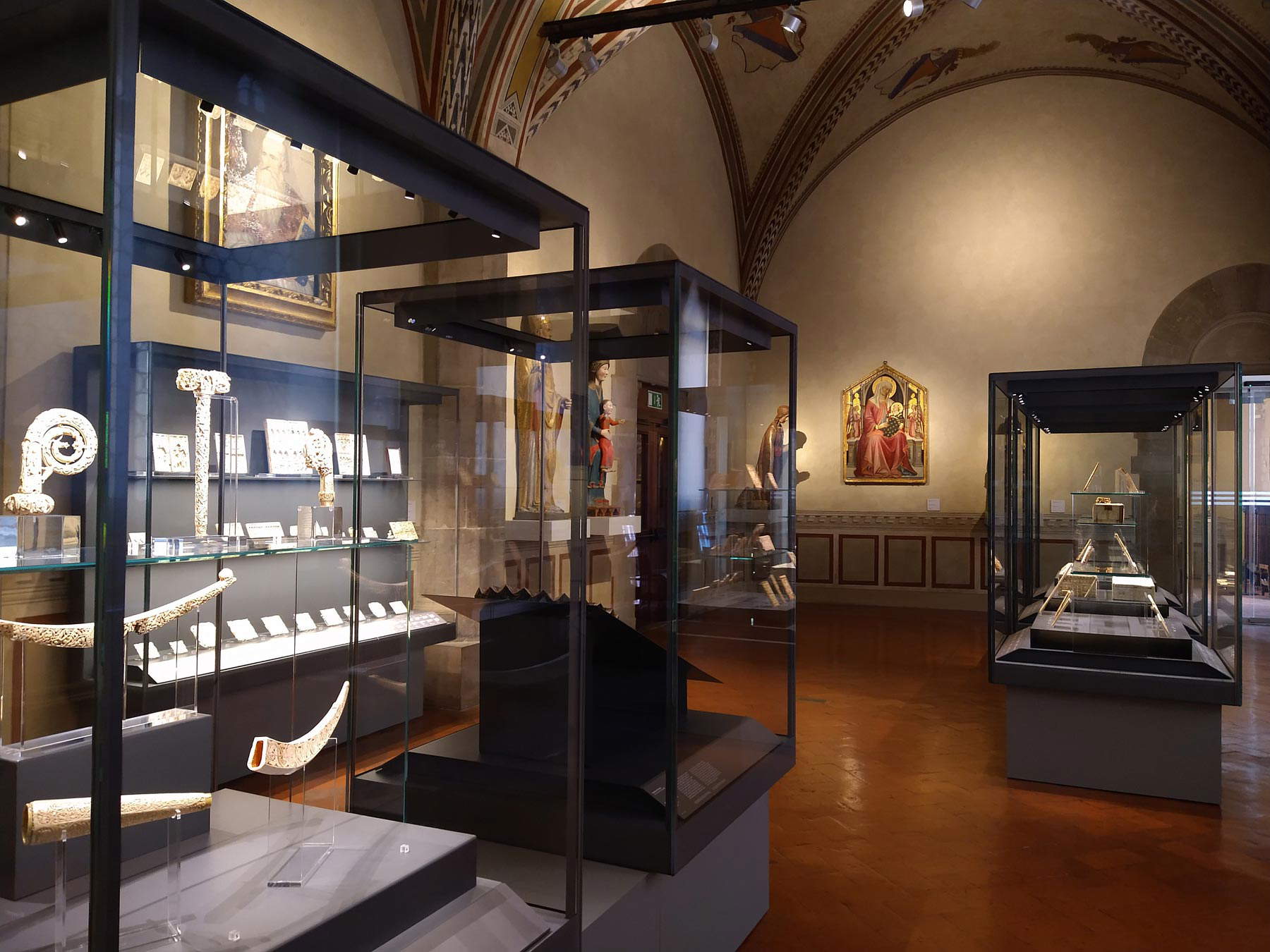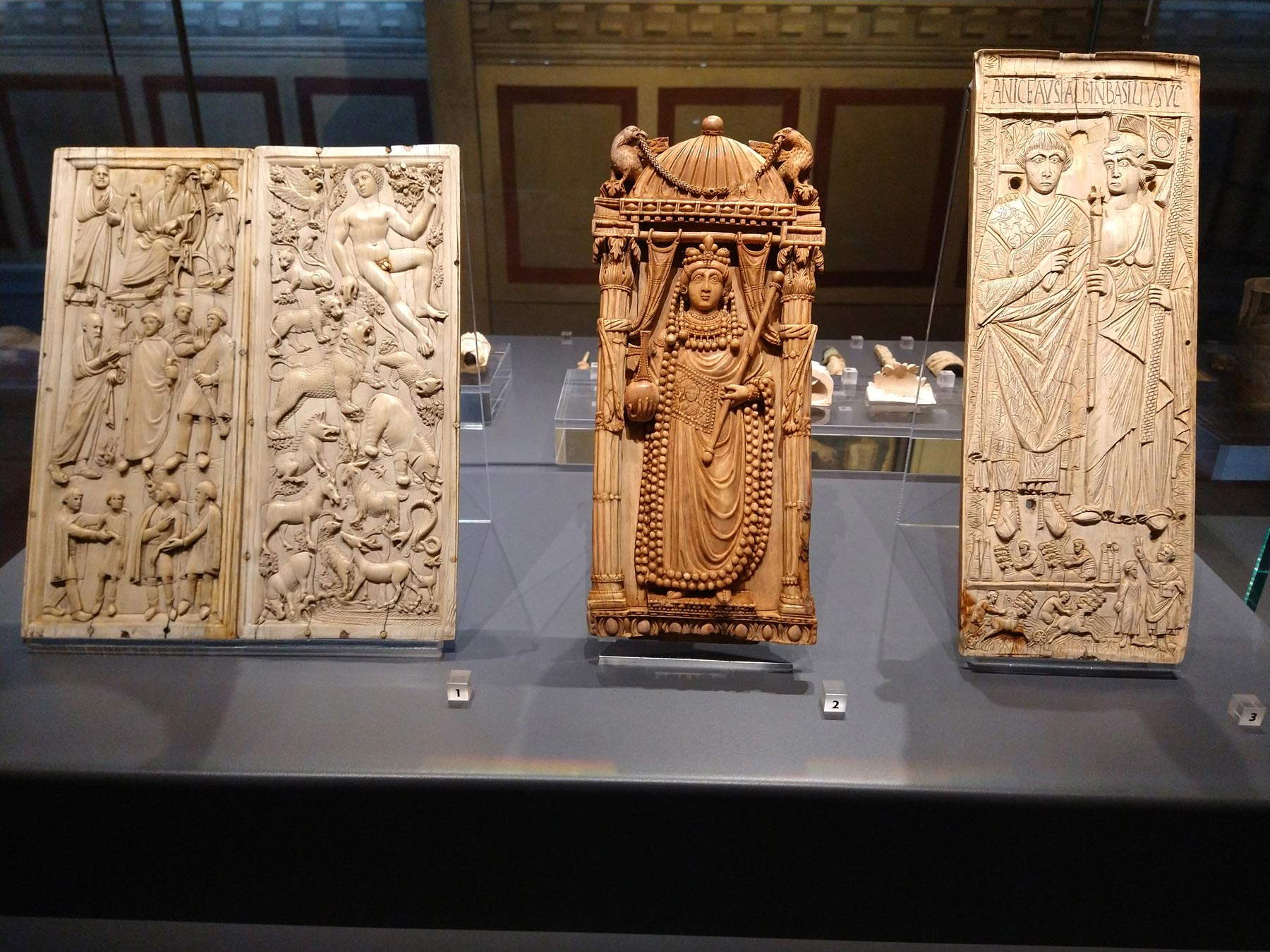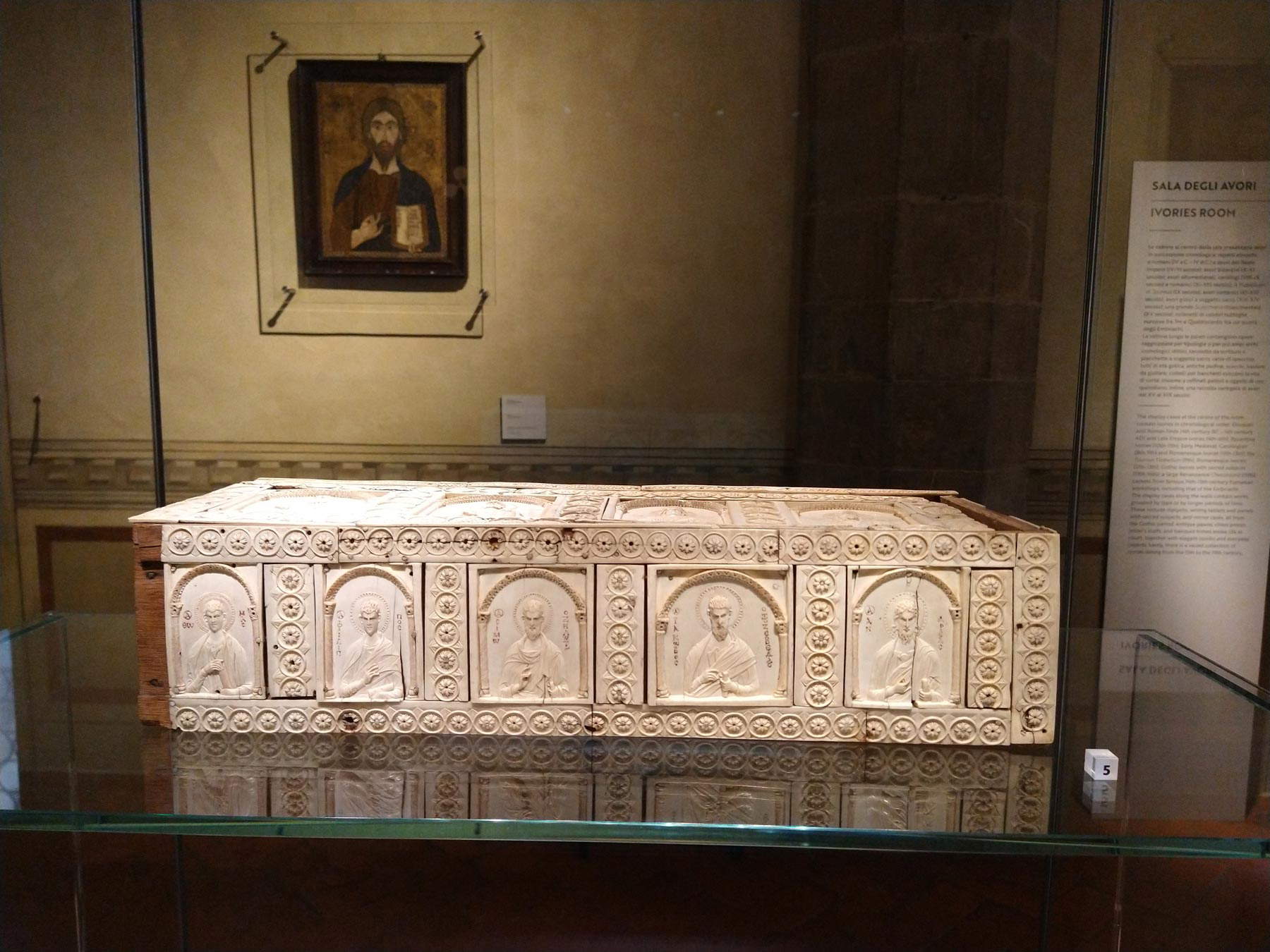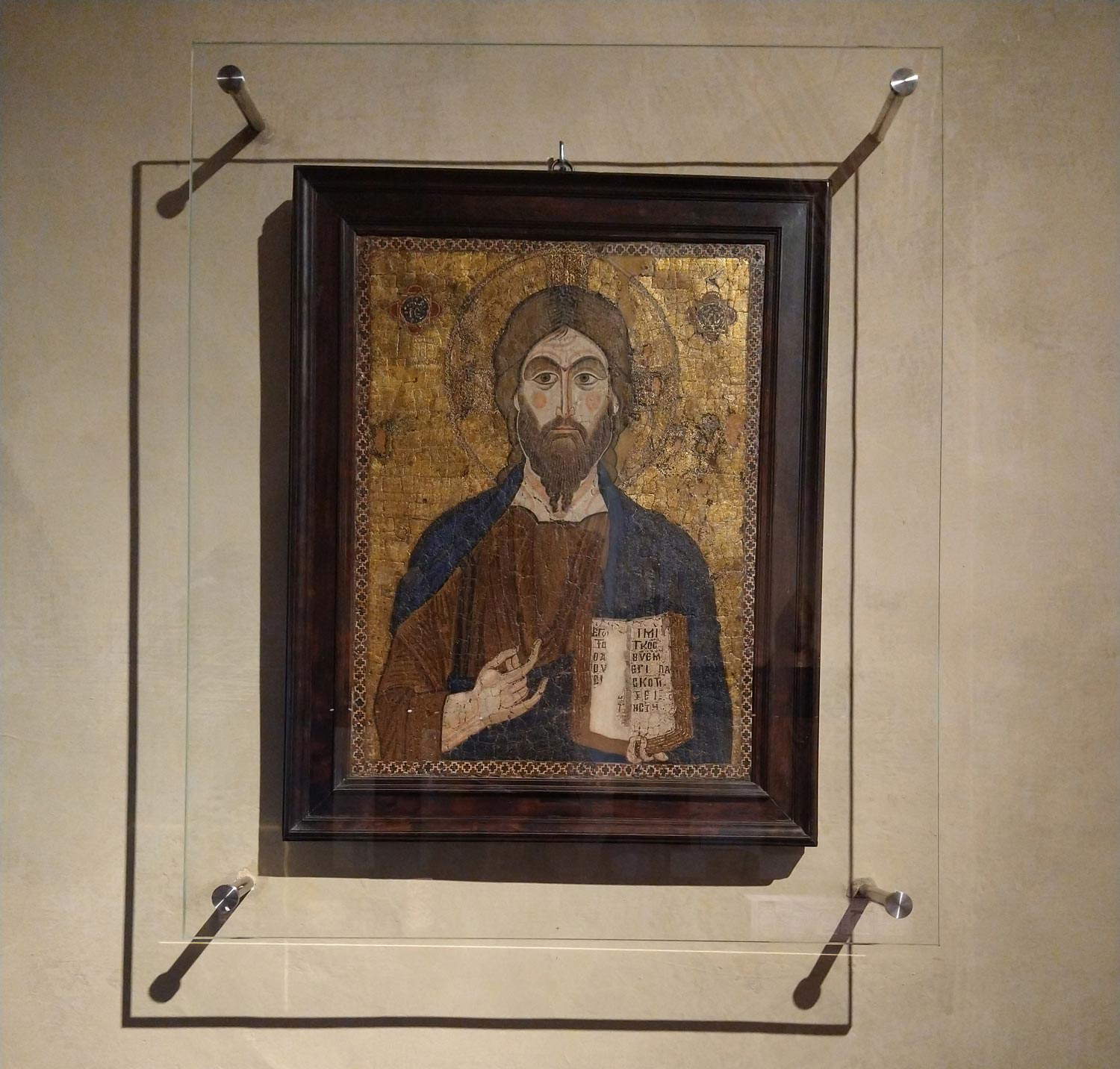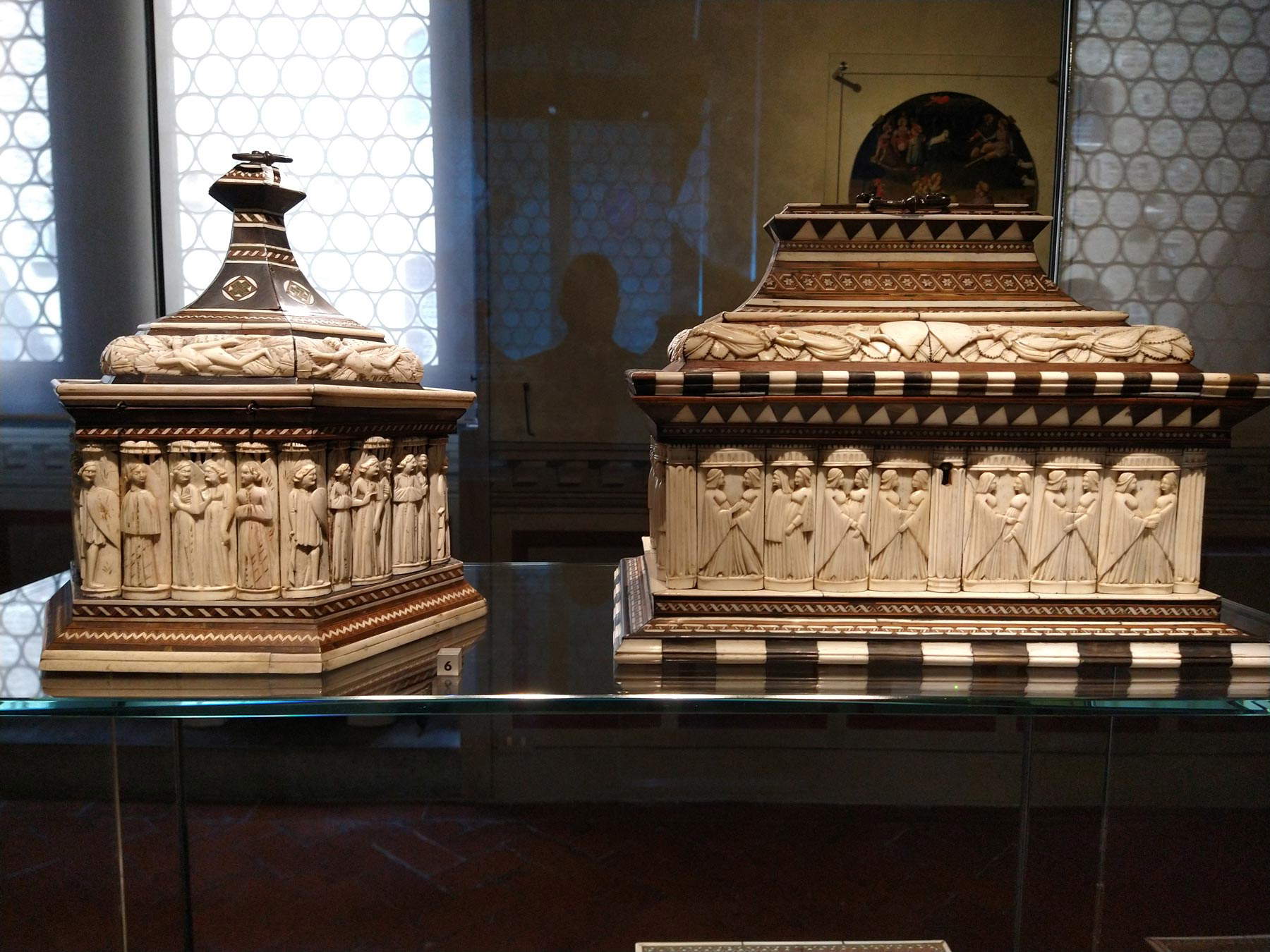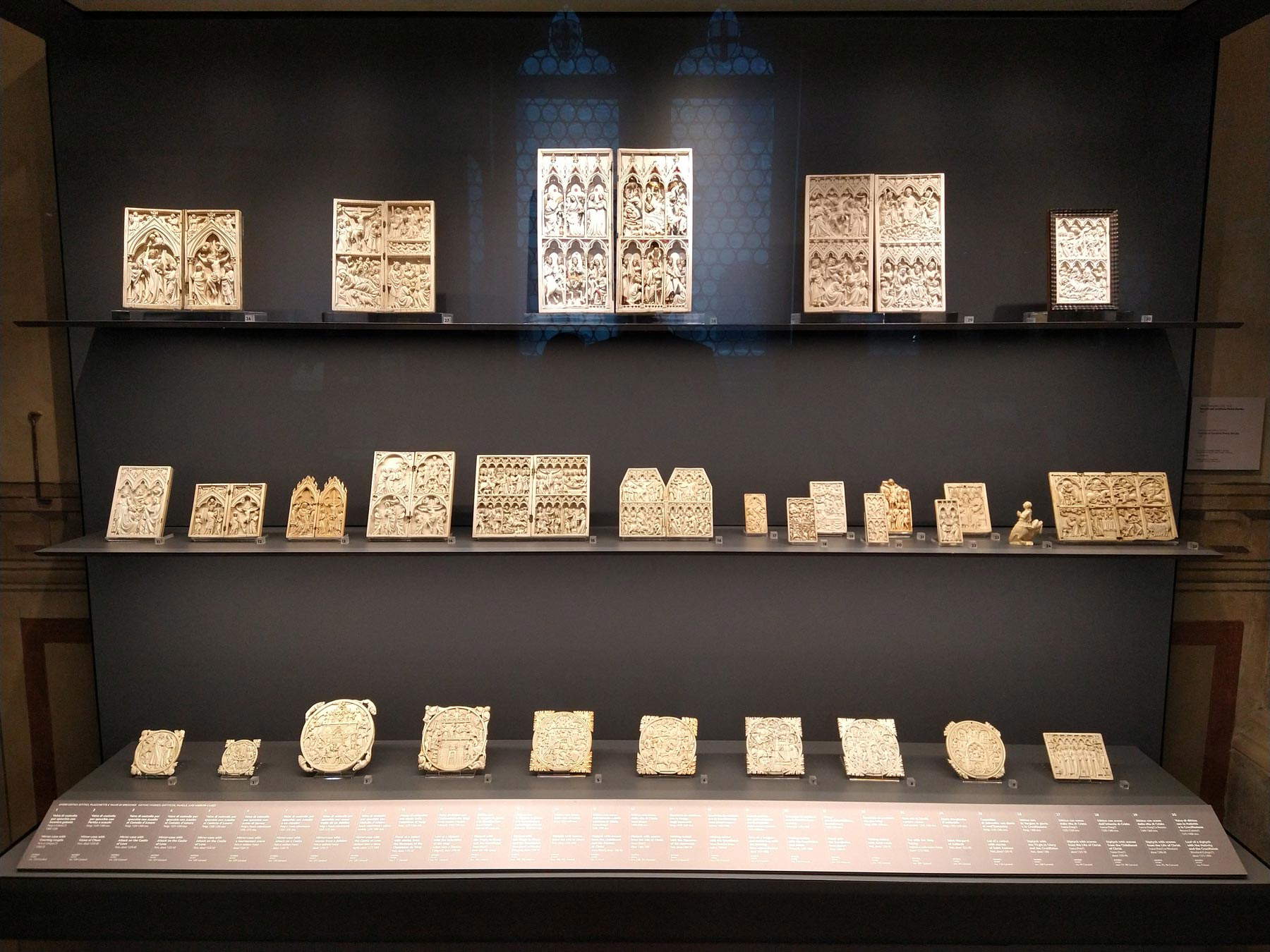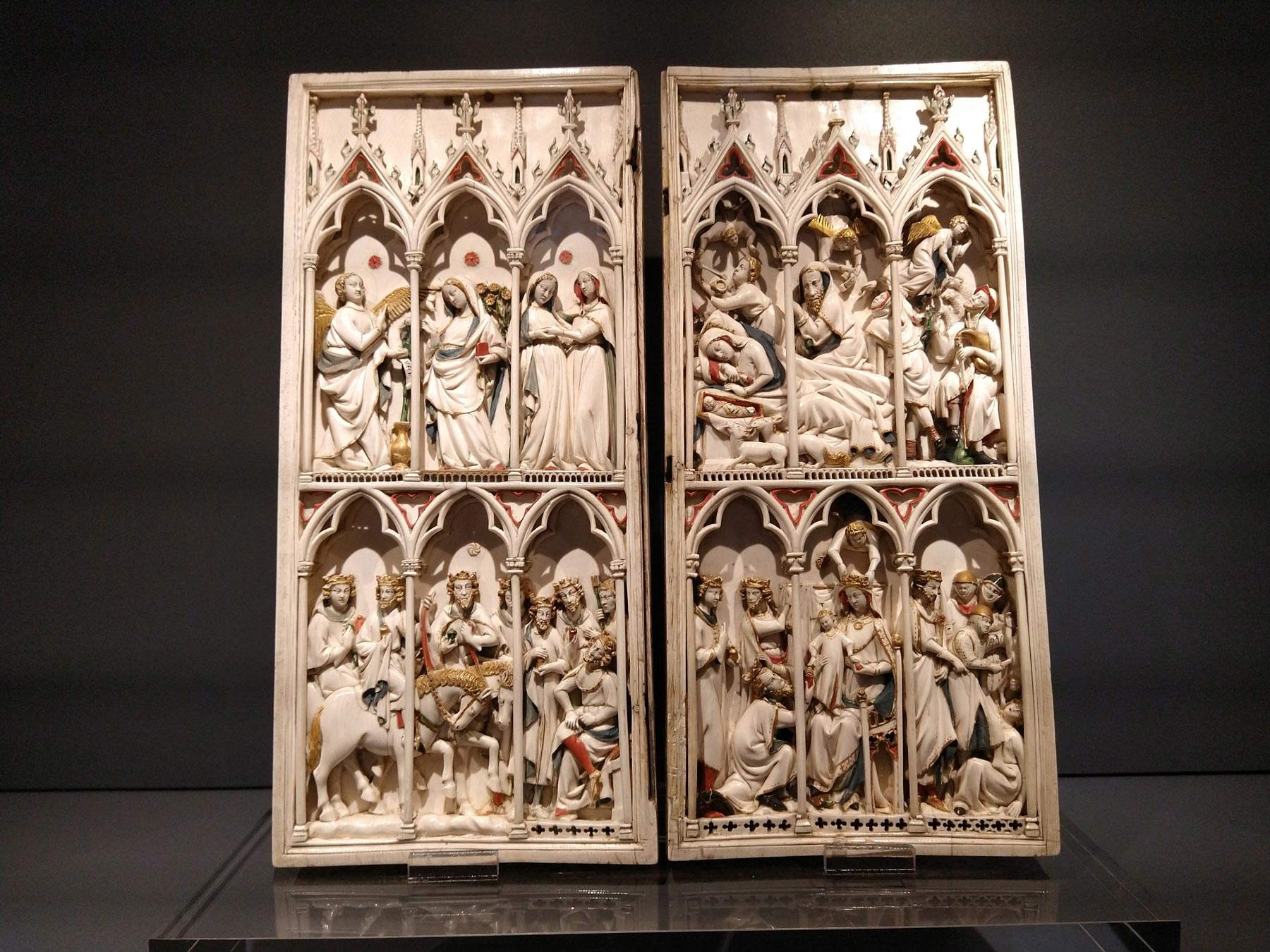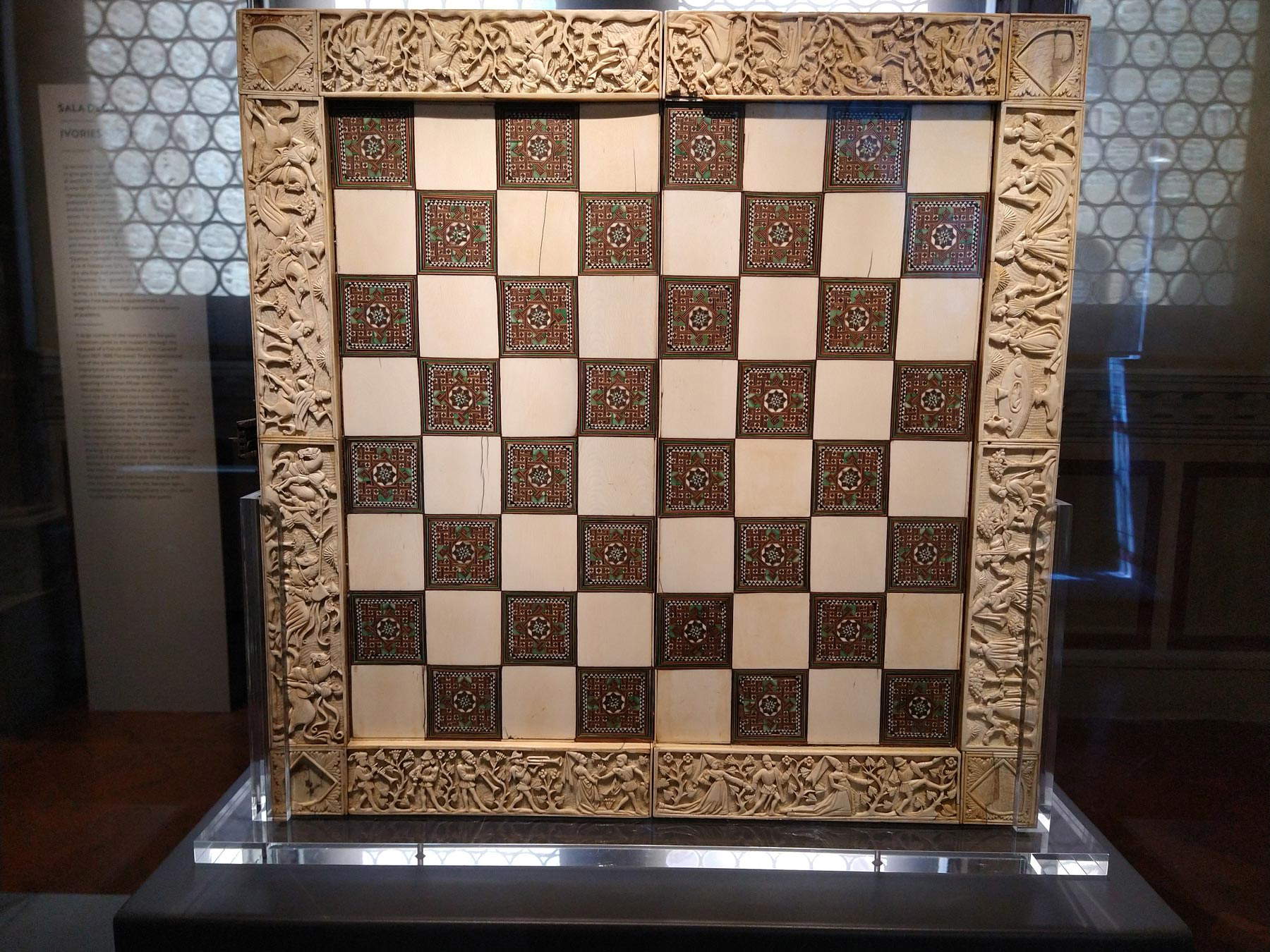by Redazione , published on 03/05/2021
Categories: Museums
/ Disclaimer
The National Museum of the Bargello in Florence reopened to the public today, and on the occasion of the reopening it unveiled the new Sala degli Avori, which has been entirely refurbished in a project that took five years to complete. On display are numerous masterpieces.
The National Museum of the Bargello in Florence reopened its doors to the public this morning after weeks of spring confinement, and took the opportunity to present to all, visitors and press alike, the new Sala degli Avori, which has been entirely rearranged, with a project curated by the Bargello Museums technical office (coordination by Ilaria Ciseri) together with the Guicciardini and Magni Architetti firm. This is the Bargello’s first complete renovation of a historicized display: the itinerary has been completely redesigned to enhance and improve the preservation of the objects of a precious and unique collection (it is among the most important ivory collections in the world), which covers several centuries of history, starting with Etruscan ivories and moving on to 17th-century masterpieces and then on to 19th-century artifacts. And it is from the seventeenth century that the sumptuous Baroque ivory crucifix is again on public display after an absence of about 100 years.
The approximately 250 objects in the collection, of exceptional value (the bulk of the collection dates back to the bequest of French antiquarian Louis Carrand, who in 1888, when he passed away, granted the Bargello about 2.600 works including sculptures, jewelry, textiles, goldsmithing and, indeed, ivories, but a decade earlier the Bargello was already in possession of a first nucleus of “Avori, Ambre e Cristalli di Monte” originated thanks to the collecting of the Medici and Lorraine families), have been arranged within new metal showcases with anti-reflective and shatterproof glass, completely airtight and equipped with internal microclimate control systems. The two-tone color scheme of the showcases declares their belonging to the double system of relationships that the museographic display weaves with the building (the warm gray of the exteriors of the showcases in relation to the decorations of the hall) and with the works (the dark gray of the interiors to make the ivories stand out better). The graphics, composed by Rovai Weber studio, follow this spectrum of variations, while the lighting, designed by Massimo Iarussi, draws the contours of the works by detaching them from the background. Work began in 2015, when the Fondazione Il Bargello Onlus funded a feasibility study of the room and helped overhaul the room’s murals, which were restored. The operation cost 490,000 euros, and the contract was handled by Invitalia (awarded to the firm Mario Verrazzo: after that, the delicate work of building modern display cases and creating the layout began, under the expert supervision of Ilaria Ciseri, Maria Cristina Valenti, and architect Marco Magni).
 |
| The new Hall of Ivories of the Bargello Museum in Florence |
 |
| The new Room of the Ivories of the Bargello Museum in Florence |
 |
| Etruscan and Roman ivories |
 |
| Lower Empire ivories: the diptych with scenes from the life of St. Paul and with Adam in the Earthly Paradise, the 6th-century plaque with empress and the left valva of the diptych of the consul Anicius Faustus Albinus Basil |
 |
| Byzantine ivories |
 |
| Byzantine ivories |
 |
| The micromosaic with Christ Pantocrator |
 |
| The Flabellum of Tournus |
The new itinerary among the Bargello’s ivories.
“The new layout,” the director of the Bargello Museum, Paola D’Agostino, explains to Finestre sull’Arte, “introduces a new coherence, thanks to Dr. Ilaria Ciseri’s layout. It has been made following chronological and thematic criteria: we start with Etruscan, Roman and Byzantine ivories, then we move on to Carolingian and Gothic ivories and so on, plus there are typological showcases, such as that of the wonderful 17th-century Crucifix, which had not been on display for more than a hundred years. The feasibility project was set up in 2015 and then, thanks to funds derived from autonomy, we started working on the project, which was sent out to tender in June 2018 with Invitalia and then awarded in June 2019. The showcases took almost a year to manufacture, as they follow a scrupulous set of museographic criteria (climate sealing, anti-reflective glass), plus each stand was built individually. Coming soon, the Bargello Museum will reopen the chapel, which is closed at the moment, but part of the gold collection has been remounted there, and it will open next week at the opening of the Dante exhibition (it will be part of the exhibition itinerary of the review). In addition, we had to close the medagliere for now because we should refit it but we had to postpone the work due to pandemic. The next steps will be the refitting of the Hall of the Fourteenth Century and the Hall of Majolica, with a project by the Guicciardini and Magni studio.”
The work done on the Hall of Ivories, D’Agostino explains, “is the first in a series of projects planned at the Bargello National Museum for the securing, enhancement and new use of the magnificent collections of decorative arts, preserved in the Palazzo del Podestà, and still too little known to the general public. This is why we decided to present the new rearrangement on the day of the museums’ reopening, after months of forced closure but great work by the staff of the Bargello Museums and various professionals engaged in construction sites on all five museums. We believe, in fact, that visitors are the real deccezione guests and we wanted to welcome them, making them appreciate a preview of these extraordinary davorio micro-masterpieces, from different cultures, unique in the world and rearranged with new and striking combinations, safely and in a new light.”
The tour begins with Etruscan and Roman ivories: knife handles, plaques, a putto head, four putto busts with garland, and more. Then we move on to the ivories of the lower empire, among which is a diptych with scenes from the life of St. Paul and with Adam in the Earthly Paradise, from Milan or Rome and dating from the late 4th century. Also of note are the plaque with empress from the 6th century and the left valva of the diptych of consul Anicius Faustus Albinus Basil. Byzantine ivories are represented by works such as the rosette cassette, from Constantinople, dating from the 10th century, and the coeval cassette with busts of Christ, the Virgin and saints. Not to be missed is the micromosaic with Christ Pantocrator, a masterpiece of Byzantine art from around 1150-1175 that Lorenzo the Magnificent had above his bed when he passed away. The public then gets to see the display case reserved for the Flabellum of Tournus, perhaps the Bargello’s most famous ivory: from the Carolingian period (circa 870), it is an object that functioned as a fan, to keep out insects during Mass. Its handle is composed of bone cylinders carved with themes alluding to Earthly Paradise, while the scroll bears figures of saints and a dedication to the Virgin and Saint Philibert in gold and silver lettering. Then we come to the Gothic ivories with sacred subject matter: here, then, are several enthroned Madonnas from various periods (ranging from the early 13th century to the mid-14th century), including the Madonna of the Grand Dukes, and the curl of the pastoral of the Acerenza Metropolitan, a work from around 1360-1390.
As for Renaissance, Baroque and modern ivories, the Madonna and Child Crowned by Angels from Spain (ca. 1650-1700), the Peace with the Flemish Madonna and Child from ca. 1500-1520, and the Christ at the Pillar from the German or Italian area of the mid-16th century stand out. One showcase is devoted to the spectacular Game Board made of ivory, bone and wood from about 1450-1480: it is one of the largest in the world and was used to play checkers, chess, tric trac and backgammon (it is painted on two sides to allow for different games and is a masterpiece of Burgundian or Flemish production: around the perimeter, moreover, are scenes of knights, ladies, hunting parties, musicians and dances, and images related to the theme of “love gardens”). Another showcase is precisely devoted to pawns and chessmen from different eras, and yet another displays fine caskets. The itinerary ends with the aforementioned Christ Crucified referred to the unknown “Master of Guadalcanal,” named after the Andalusian town where several crucifixes similar to the one in the Bargello are found: the artist worked between Andalusia and Genoa in the second half of the seventeenth century, and with this Christ he achieves a masterpiece of virtuosity, where the skill of ivory workmanship reaches levels of microscopic subtlety.
 |
| Casket Showcase |
 |
| Gothic ivories |
 |
| Gothic ivories |
 |
| Gothic ivories |
 |
| The game board |
 |
| The Crucifix of the Master of Guadalcanal |
The statements
“Today a project to which we have long aspired comes true, since the pre-existing showcases, built in the 1980s,” explains Ilaria Ciseri, Head of Collections at the Bargello National Museum, “no longer guaranteed adequate display parameters for the delicacy of the ivory works. At last, these masterpieces find ideal microclimatic conditions and can be admired in all their extraordinary beauty, enhanced by a staging and lighting that bring out previously unimaginable details. And finally, a decceptional display is that of a never-before-seen masterpiece, the touching Baroque Crucifix that returns to the exhibition after almost a century of absence.”
“For the creation of the new display cases in the Sala degli Avori,” explained architect Maria Cristina Valenti, head of the technical office of the Bargello Museums and RUP of the work, “the old display cases were dismantled, the 19th-century pictorial apparatus on the walls and the terracotta floor were restored. On the walls, both the paintings - mosaics and panels - and the wood and marble sculptures were arranged in a different historical order, using the old bases covered in corian. The windows restored, motorized roller blinds made of filtering fabric with UV protection were inserted. A new electrical system and new point lighting of the hall was made to enhance the artworks displayed on the walls with spotlights and LED strips.”
“It was necessary,” said architect Marco Magni, “to identify new criteria that could adapt to the peculiarities of the different sections to be renovated, and at the same time represent a note of style and exemplary clarity at the service of this specific museum, while solving problems of conservation, management and enhancement of the works. The configuration of the display cases is generated by the arrangement of the collections, but also by the design of the nineteenth-century decorations of the room.”
“Fondazione il Bargello - Onlus has been close to the Bargello National Museum since its inception as an Association in 1982,” added Sergio Chiostri, President of Fondazione Il Bargello Onlus. “Since then it has helped the Museum financially to implement a range of initiatives to improve the usability of the works on display. This includes the funding that, at the same time as the refurbishing of the Hall of Ivories and the goldsmiths’ work in the Sacristy and Chapel, has made it possible to create a new graphic design and educational apparatus, in Italian in English.”
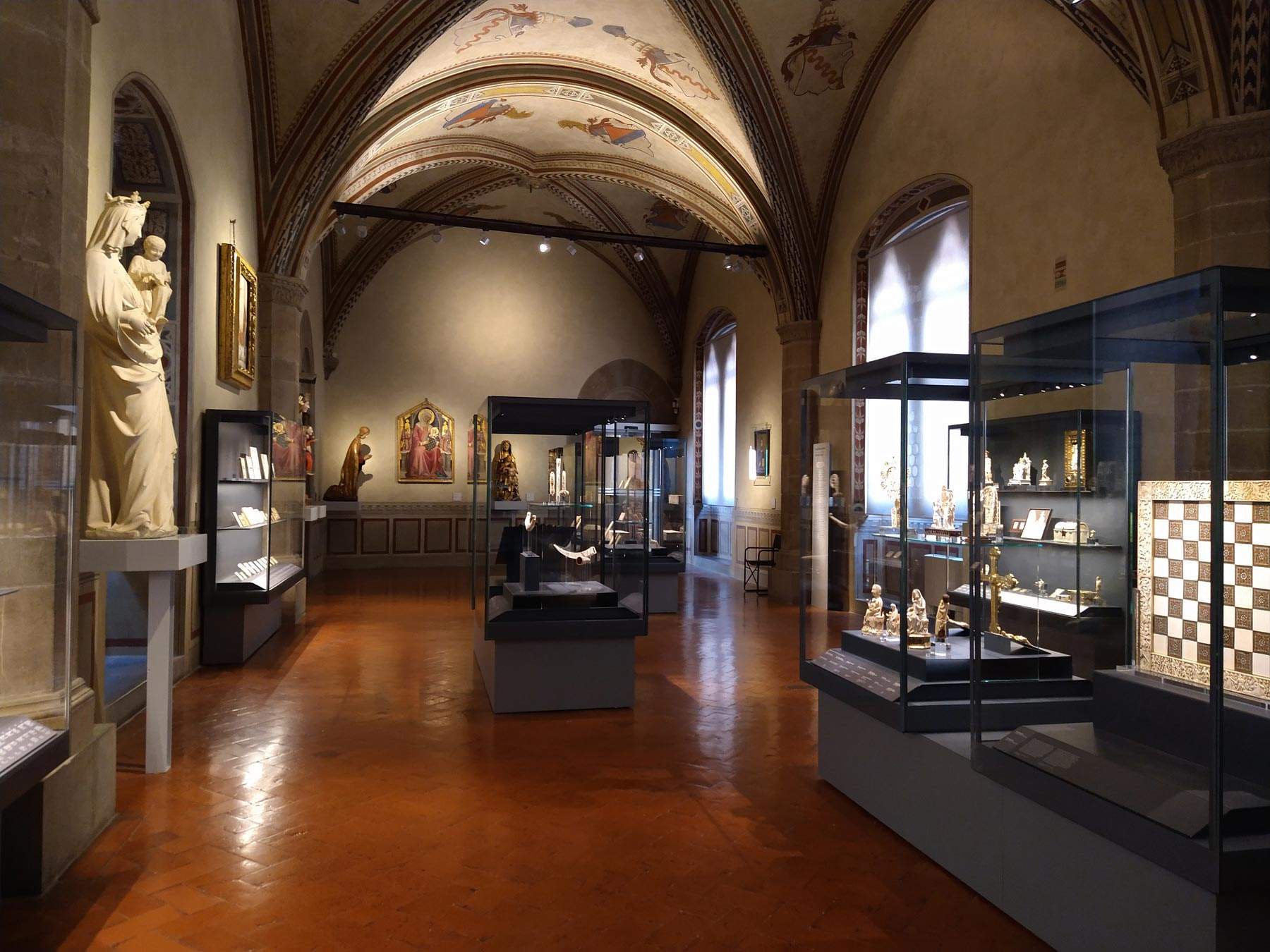 |
| Florence, the Bargello Museum reopens and unveils the new Sala degli Avori, all refurbished |
Warning: the translation into English of the original Italian article was created using automatic tools.
We undertake to review all articles, but we do not guarantee the total absence of inaccuracies in the translation due to the program. You can
find the original by clicking on the ITA button. If you find any mistake,please contact us.

